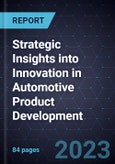Disruptive Technologies, such as Digital Twins, Generative Design, Virtual Prototyping and Mixed Reality, to Transform Product Development Processes and Ensure Quicker Time to Market
A surge in technical developments is fueling change in the automotive sector. This growth opportunity analytics investigates cutting-edge technologies revolutionizing the industry. Digital drivers, such as AI-generative design, quantum simulation, mixed reality, digital twins, virtual prototyping, smart factories, virtual workspaces, and machine vision systems are speeding up automotive product development, reducing time and costs, and promoting sustainability.
This analysis investigates how AI-generative design enables designers and engineers to produce optimized automobile components while reducing multiple design iterations. The impact of quantum simulation is analyzed, showcasing its ability to simulate and optimize critical aspects, such as chemical reactions, material properties, and aerodynamics, ultimately leading to the development of more efficient engines, batteries, and lightweight materials. It explores mixed reality's disruptive potential, demonstrating how augmented reality (AR) and virtual reality (VR) enable quick design iteration and worldwide collaboration, and deep dives into the influence of smart factories and virtual workspaces on automotive production, highlighting how these developments improve efficiency, productivity, and collaboration.
This comprehensive analysis covers the impact, timeline, and major outcomes achieved through the implementation of digital drivers in automotive product development. In conclusion, it offers a profound understanding of the transformative innovations taking place in the automotive industry. By harnessing the power of digital drivers, automotive OEMs have been able to revolutionize their product development processes.
Table of Contents
Companies Mentioned (Partial List)
A selection of companies mentioned in this report includes, but is not limited to:
- Autodesk AI
- BMW
- ESTECO Engineering
- Ford
- General Motors
- Hyundai








